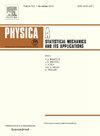Localization and magnetic field effects in Heisenberg chains with generalized exponentially correlated disorder
IF 2.8
3区 物理与天体物理
Q2 PHYSICS, MULTIDISCIPLINARY
Physica A: Statistical Mechanics and its Applications
Pub Date : 2025-01-15
DOI:10.1016/j.physa.2024.130287
引用次数: 0
Abstract
We examine the properties of the one-magnon eigenstates in a Heisenberg chain with correlated disorder in the presence of a magnetic field that increases linearly along the chain. The disorder distribution is tailored to have intrinsic generalized exponential correlations. We further analyze the dynamic localization of an initial wave packet and discuss how it is influenced by the correlations and the strength of the magnetic field. We find that localized eigenstates are predominant when the correlated disorder is characterized by a slower dependence of the effective correlation length on the system size. In contrast, when the effective correlation length increases at least with the square root of the system size, low-energy eigenmodes undergo a transition to nearly delocalized modes. We go further to analyze the impact of a linearly varying magnetic field on the system dynamics. An initial Gaussian wave packet is shown to exhibit dynamic localization, characterized by an oscillatory behavior reminiscent of Bloch oscillations at specific correlation levels, before being damped in the long time limit. Our findings advances the understanding of localization and transport properties in the field of coherent magnonics as contributes to the design of correlated disordered media.
求助全文
约1分钟内获得全文
求助全文
来源期刊
CiteScore
7.20
自引率
9.10%
发文量
852
审稿时长
6.6 months
期刊介绍:
Physica A: Statistical Mechanics and its Applications
Recognized by the European Physical Society
Physica A publishes research in the field of statistical mechanics and its applications.
Statistical mechanics sets out to explain the behaviour of macroscopic systems by studying the statistical properties of their microscopic constituents.
Applications of the techniques of statistical mechanics are widespread, and include: applications to physical systems such as solids, liquids and gases; applications to chemical and biological systems (colloids, interfaces, complex fluids, polymers and biopolymers, cell physics); and other interdisciplinary applications to for instance biological, economical and sociological systems.

 求助内容:
求助内容: 应助结果提醒方式:
应助结果提醒方式:


